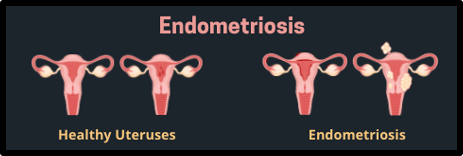Endometriosis Awareness Month
March is endometriosis awareness month. It’s an important one, because despite affecting 1 in 9 Australian women, very little is known about the condition. For the whole of March, pelvic health advocates, QENDO, are helping to raise awareness about endometriosis.
With medicine and science being largely male-dominated industries, many conditions that solely affect women simply have not been researched enough. This gender disparity is slowly closing, however, and we are starting to understand disorders like endometriosis better.
So, what do we know?
What is endometriosis?
Endometriosis is a pelvic condition that causes the womb-lining cells to grow elsewhere in the pelvis. These cells – endometrium – are the ones that protect embryos as they grow, which are released as menstrual flow if a fertilised egg is not implanted.
When growing outside the uterus, the endometrium still respond to the female reproductive signals. They grow and break down as they are meant to, but in areas of the body that cannot cope with it, creating cysts and small scars as well as inflammation.
Sometimes, this happens in other parts of the reproductive system, such as the ovaries and vagina. Other times, the cells grow outside the reproductive system altogether, for example on the bladder or intestines.
When the endometrium exist outside of the uterus, their sticky material which would usually be contained is unrestricted. This can cause organs to stick together – an extremely painful phenomenon called frozen pelvis syndrome.
How is endometriosis diagnosed?
Diagnosing endometriosis starts with talking about your symptoms, but to confirm a clinical diagnosis, your doctor may refer you for a pelvic ultrasound or keyhole surgery.
On average, it takes women over 7 years to be diagnosed with endometriosis. That’s 7 years of pain before finding its cause, let alone receiving treatment. There are a few reasons for this lengthy wait, the main one being that the symptoms largely replicate those of severe period pains.
We will go into the symptoms of endometriosis later this month, but at a top-level, they include extreme menstrual cramps, pain during sex or going to the bathroom, a very heavy menstrual flow, depression and infertility.
One of the main reasons that it is so important to raise awareness for endometriosis is to normalise it. The more we know and understand any condition, the easier it is for doctors to spot. For women with endometriosis, a faster diagnosis time means less time spent in pain.
The stages of endometriosis
Once a diagnosis is confirmed, doctors might grade your endometriosis by severity (stage 1 being mild, stage 4 being severe). This includes how many lesions you have, how deep they are and whether cysts are present in the area.
These stages do not correspond to pain or symptoms, so someone with a mild diagnosis could experience more pain and worse symptoms than someone with severe endometriosis. Research is needed, therefore, to develop a more relevant scale, such as the classification by EndoFound:
Category I: Peritoneal endometriosis
The mildest category, where endometriosis is found only in the peritoneum (lining of the abdomen.
Category 2: Ovarian Endometriomas (Chocolate Cysts)
Endometriosis in the ovaries. Ovarian cysts are present and have a high risk of spreading to other parts of the pelvis.
Category 3: Deep Infiltrating Endometriosis 1 (DIE 1)
The milder form of deep infiltrating endometriosis (DIE), where endometriosis is present on organs in the pelvis. Patients are at risk of frozen pelvis syndrome from DIE.
Category 4: Deep Infiltrating Endometriosis 1 (DIE 2)
A more severe form of DIE, which can involve organs anywhere in the body.
QENDO March
Endometriosis is a painful and often debilitating health condition that affects 830,000 Australian women. It presents itself differently in everyone, and research is only just beginning to look for a cure.
By raising awareness and funds during Endometriosis Awareness Month, you can help make women’s health research a priority. Attend an online event or donate to QENDO to help be a part of finding the cure for endometriosis.
If you are worried about your own reproductive health, reach out to your doctor. If your doctor does not suggest endometriosis, don’t be scared to bring it up yourself. Many doctors are still unaware of how its symptoms can affect people differently.




